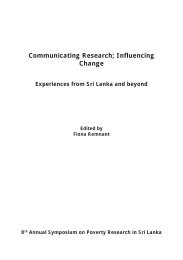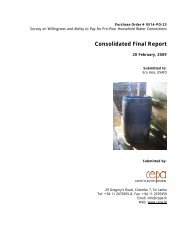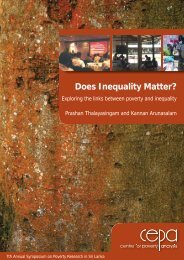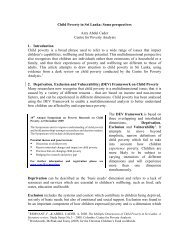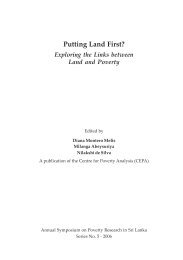Involuntary Displacement and Resettlement â Policy and ... - CEPA
Involuntary Displacement and Resettlement â Policy and ... - CEPA
Involuntary Displacement and Resettlement â Policy and ... - CEPA
- No tags were found...
Create successful ePaper yourself
Turn your PDF publications into a flip-book with our unique Google optimized e-Paper software.
for government <strong>and</strong> NGOs alike to be better prepared to serve the needs ofthe urban poor not only in terms of policy, but also from a humanistperspective.Lastly, there is an entire body of resettlement literature to reference. In hisexamination of resettlement packages offered to families that weredisplaced by the Ilisu Hydropower Project in southern Turkey, Morvaridi(2004) found that families who chose the government-assisted resettlementpackage (which included l<strong>and</strong>, a house <strong>and</strong> livelihood assistance – <strong>and</strong>therefore is similar to the donor-driven schemes above) fared much betterthan families that chose cash compensation <strong>and</strong> self-settlement (728; 732),who were plagued by many of the same problems noted above (i.e., lategovernment payments, inflation in the marketplace). When offering cash,the government can simply wash its h<strong>and</strong>s off after payment, whereas in anassisted scheme the government essentially has to work ‘harder’ to ensurethat the ‘transition’ to the new site is complete. In post-tsunami Sri Lanka,affected persons did not have the right to choose their own method ofresettling/relocating.Below I offer some recommendations with respect to the design ofresettlement packages <strong>and</strong> how self-settlement schemes could be betterdesigned to meet the needs of women <strong>and</strong> the urban poor.One size does not fit all: From an administrative position, a blanketpolicy might seem easiest, but people are unique <strong>and</strong> havedifferent sets of circumstances. If this is recognised <strong>and</strong> takenseriously from the beginning, then serving the entire population willbe more likely to happen rather than leaving people behind who ‘donot fit’ in. Finding good ‘fits’ for different resettlement options mayinclude conducting background assessments of the affectedpopulation in order to match their skills, experience <strong>and</strong> specialneeds (i.e., literacy levels) to the dem<strong>and</strong>s of potential resettlementpackages.Attitudes towards affected persons need to change: Government<strong>and</strong> NGO officials need to re-orient their attitudes to consideraffected persons as clients that they are responsible for, not asbeneficiaries who should be grateful <strong>and</strong> take whatever they areoffered without complaint.201



